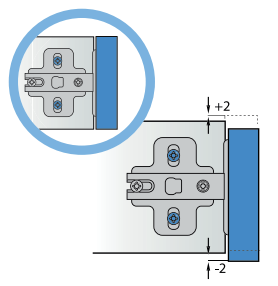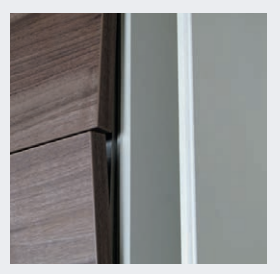Adjusting the Drawer Fronts

Metal Drawer Box
To adjust the drawer front vertically clip off the cap, rotate the grooved wheel clockwise/anti-clockwise.

Timber Drawer Box
Using a screwdriver, slacken the screws that attach the frontal to the drawer box, align the frontal accordingly and re-tighten the screws. It may be easier to remove the lower screws completely for alignment.
Adjusting the Door

Side
The side adjustment is made by rotating the appropriate screw on the hinge arm.

Height
For height adjustment the two mounting plate fixing screws have to be temporarily released while making the manual adjustment.

Depth
The depth adjustment is made by temporarily releasing the adjustment/fixing screw. After the adjustment is made the screw has to be re-tightened.
Adjusting Bi-Folds

Unit panel does not stay in position - Spring force is too low
Remove the housing cover. Using a socket spanner (4mm), increase the force by turning the spanner anti-clockwise (the adjustment slide moves down). This adjustment procedure must be performed on both lifting arms.

Unit panel opens too quickly and springs upward - Spring force is too high
Remove the housing cover. Using a socket spanner (4mm), reduce the force by turning the spanner clockwise (the adjustment slide moves up). This adjustment procedure must be performed on both lifting arms.
Unit door is not aligned when closed - Base bodies have not been correctly adjusted

Once the kitchen has been installed (or adjustment work has been performed on the front panels), the front panels may not close cleanly. You can adjust the base body or hinges to improve the closing action.

Slacken the two external fixing screws on the base body and adjust the height using the eccentric screw. Once the correct position has been reached, you must re-tighten the fixing screws. This adjustment procedure must be performed on both lifting arms

Do not use a cordless screwdriver.
The two fixing screws must be re-tightened following adjustment.
Paint to Order Colours
Find the perfect colour scheme with our choice of on trend finishes
Chalk White
Harbour
Cashmere
Stone
Clay
Platinum
Pearl Grey
French Grey
Providence Blue
Hessian
Sage
Fern Green
Willow
Dusky Pink
Carmine Red
Caramel
Anthracite
Midnight Blue
Indigo
Hunter Green
Bottle Green
Black
Paint to Order Colours
Find the perfect colour scheme with our choice of on trend finishes
Chalk White
Harbour
Cashmere
Stone
Clay
Platinum
Pearl Grey
Providence Blue
Sage
Fern Green
Dusky Pink
Willow
Paint to Order Colours
Find the perfect colour scheme with our choice of on trend finishes
Chalk White
Harbour
Platinum
Pearl Grey
Stone
Sage*
Fern Green
French Grey*
Providence Blue
Cashmere
Dusky Pink
Ivy
*Please note these paint colours are not a match to the Laura Ashley paint colours of the same name.
View Brochure(s)
"*" indicates required fields
Ask us a Question
Please complete your details so our retailer can get in touch



